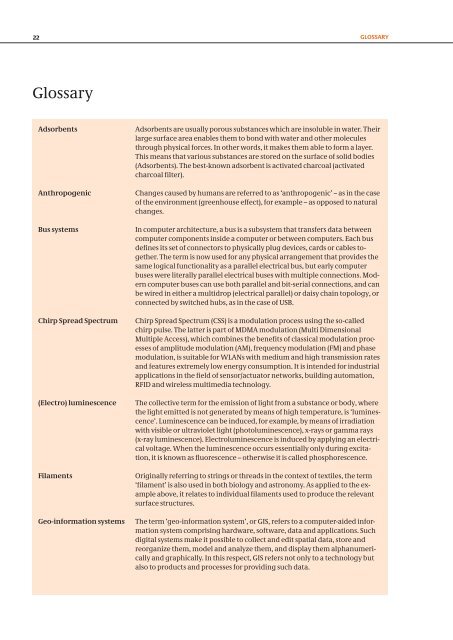Research for Civil Security
Research for Civil Security
Research for Civil Security
- No tags were found...
Create successful ePaper yourself
Turn your PDF publications into a flip-book with our unique Google optimized e-Paper software.
22 glOSSaRyGlossaryAdsorbentsAnthropogenicBus systemsChirp Spread Spectrum(Electro) luminescenceFilamentsGeo-in<strong>for</strong>mation systemsAdsorbents are usually porous substances which are insoluble in water. Theirlarge surface area enables them to bond with water and other moleculesthrough physical <strong>for</strong>ces. In other words, it makes them able to <strong>for</strong>m a layer.This means that various substances are stored on the surface of solid bodies(Adsorbents). The best-known adsorbent is activated charcoal (activatedcharcoal filter).Changes caused by humans are referred to as ‘anthropogenic’ – as in the caseof the environment (greenhouse effect), <strong>for</strong> example – as opposed to naturalchanges.In computer architecture, a bus is a subsystem that transfers data betweencomputer components inside a computer or between computers. Each busdefines its set of connectors to physically plug devices, cards or cables together.The term is now used <strong>for</strong> any physical arrangement that provides thesame logical functionality as a parallel electrical bus, but early computerbuses were literally parallel electrical buses with multiple connections. Moderncomputer buses can use both parallel and bit-serial connections, and canbe wired in either a multidrop (electrical parallel) or daisy chain topology, orconnected by switched hubs, as in the case of USB.Chirp Spread Spectrum (CSS) is a modulation process using the so-calledchirp pulse. The latter is part of MDMA modulation (Multi DimensionalMultiple Access), which combines the benefits of classical modulation processesof amplitude modulation (AM), frequency modulation (FM) and phasemodulation, is suitable <strong>for</strong> WLANs with medium and high transmission ratesand features extremely low energy consumption. It is intended <strong>for</strong> industrialapplications in the field of sensor/actuator networks, building automation,RFID and wireless multimedia technology.The collective term <strong>for</strong> the emission of light from a substance or body, wherethe light emitted is not generated by means of high temperature, is ‘luminescence’.Luminescence can be induced, <strong>for</strong> example, by means of irradiationwith visible or ultraviolet light (photoluminescence), x-rays or gamma rays(x-ray luminescence). Electroluminescence is induced by applying an electricalvoltage. When the luminescence occurs essentially only during excitation,it is known as fluorescence – otherwise it is called phosphorescence.Originally referring to strings or threads in the context of textiles, the term‘filament’ is also used in both biology and astronomy. As applied to the exampleabove, it relates to individual filaments used to produce the relevantsurface structures.The term ‘geo-in<strong>for</strong>mation system’, or GIS, refers to a computer-aided in<strong>for</strong>mationsystem comprising hardware, software, data and applications. Suchdigital systems make it possible to collect and edit spatial data, store andreorganize them, model and analyze them, and display them alphanumericallyand graphically. In this respect, GIS refers not only to a technology butalso to products and processes <strong>for</strong> providing such data.
















